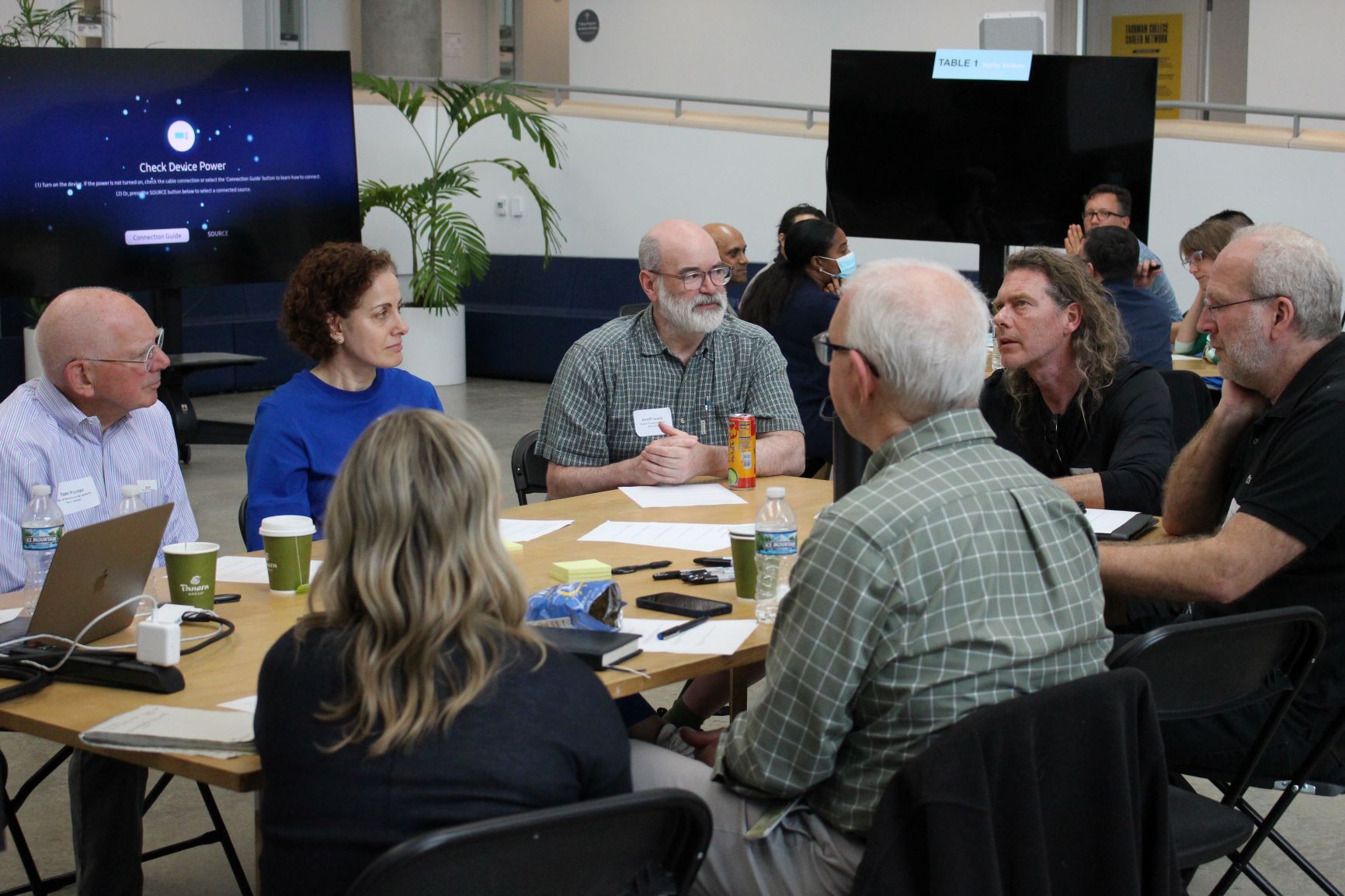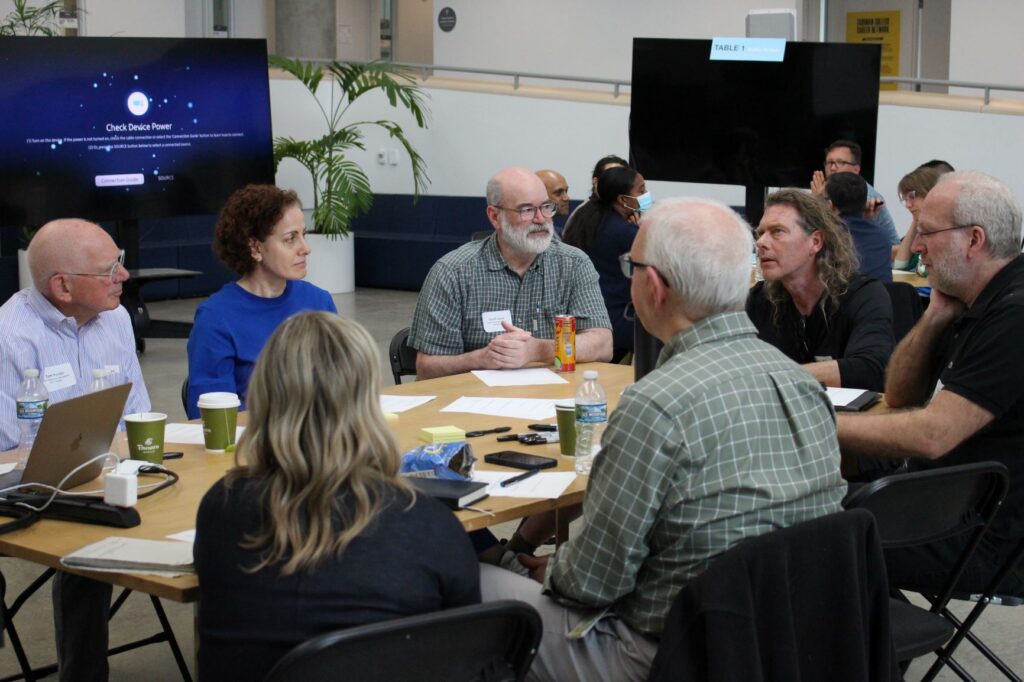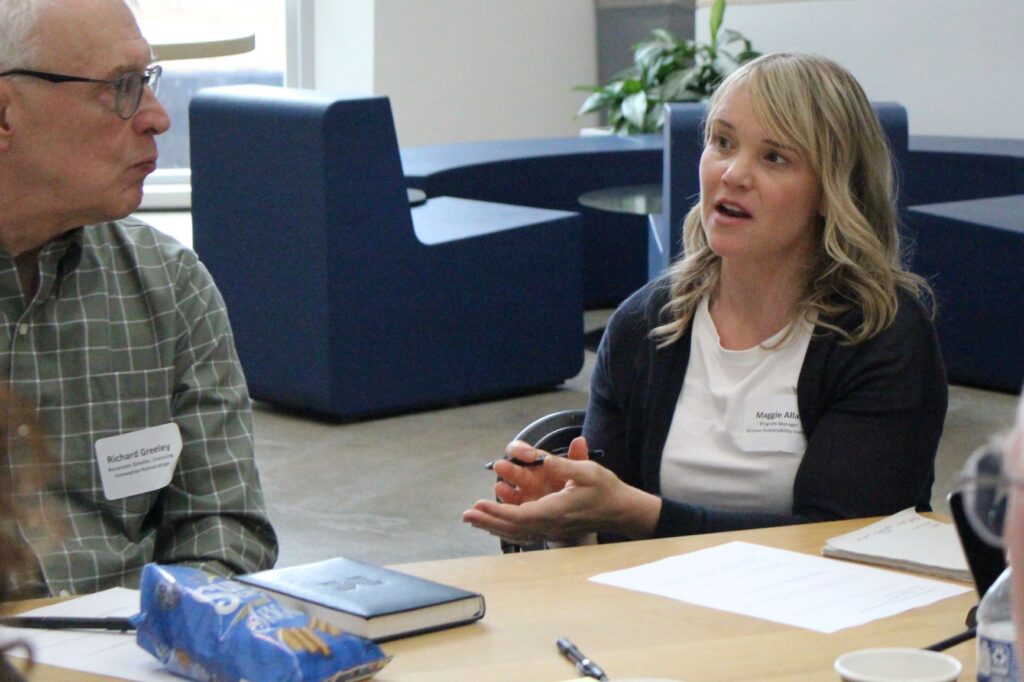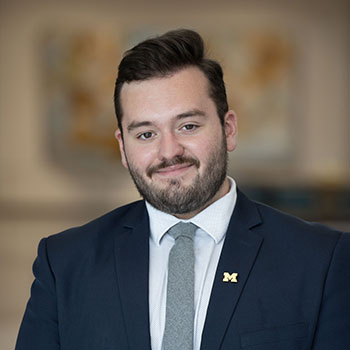
Multidisciplinary team collaborates on workshop to develop Low Carbon Building R+D Initiative
Cross-unit collaboration seeks to create a strategic vision to address research opportunities.

Cross-unit collaboration seeks to create a strategic vision to address research opportunities.
A team of faculty members from the College of Engineering, the Taubman College of Architecture and Urban Planning, and the School for Environment and Sustainability met on June 15 for a Low Carbon Building R+D Initiative workshop. Participants also included the Graham Institute for Sustainability, Innovation Partnerships, Office of the Vice President for Research (OVPR), and industry stakeholders. The goals of the session were to:
The all-day event was an opportunity to convene, advance individual and collective research interests, and co-create a strategic vision for multi-disciplinary collaboration. Russell Loveridge, the Managing Director of NCCR Digital Fabrication at ETH, and Tsz Yan Ng, from Taubman College, co-facilitated the event.

The Low Carbon Building R+D Initiative is a cross-unit collaboration led by three Associate Deans of Research: Kathy Velikov, professor at Taubman College; Eric Michielssen, Louise Ganiard Johnson Professor of Engineering in Electrical Engineering and Computer Science at the College of Engineering; and Bill Currie, professor at the School for Environment and Sustainability. Key faculty on the initiative include associate professor Tsz Yan Ng from Taubman College and, from Civil & Environmental Engineering, associate professor Brian Ellis and associate professor Evgueni Filipov.
The cross-functional group is working to advance a strategic roadmap for developing targeted research domains and building out capacity and industry partnerships that will position U-M as a leader in accelerating low-carbon building innovations. OVPR provided the group the opportunity to develop this university-wide initiative through its VPR-RAD Catalyst Grant Program, launched in 2021 to advance strategic research goals and facilitate collaboration across disciplines in key emerging areas.
“The President’s Commission on Carbon Neutrality recommended, and the University adopted, the aggressive goal to eliminate direct greenhouse gas emissions from campus by 2040,” said Greg Keoleian, CEE Professor, Peter M. Wege Endowed Professor of Sustainable Systems and co-director of the MI Hydrogen Initiative.
“Campus buildings are responsible for a majority of U-M’s scope 1 and 2 carbon emissions. The ‘living lab’ concept outlined at the workshop forms the basis for an exciting new collaboration between faculty and University Faculties and Operations to achieve the zero-emissions goal. Together we can co-create innovative solutions and accelerate the necessary building renovations, clean energy transition, and the active engagement of the University community in the process.”

Catie Newell, Associate Professor, Taubman College, added that the living labs concept is integral to this proposal. “Creating living labs is among the strongest ways to truly work on projects that will have an impact on the myriad changes that need to be made within our building sector to better serve the community and the environment.”
The living labs are envisioned as full-scale functional testbed demonstrators that will provide performance metrics to advance research and reduce risks for adoption such as costs, codes, policies, and supply chains and labor shortages. Viable and sustainable solutions will be addressed across the entire construction ecosystem, including impact on health and social equity. According to Velikov, “The built environment, from its materials procurement, design, construction processes, use and operations, is going to play a crucial role in meeting the necessary emissions reduction targets. This is a significant space of research opportunity to build new collaborations, new industry partnerships, new streams of workforce development and new research infrastructure and frameworks.” Ng added that “New research domains could also emerge through this multidisciplinary effort.”
The workshop was organized into three main events, with each representing an opportunity to highlight important research questions that could be addressed through the living lab, research expertise of the attendees, their potential contributions to the project and the required partnerships to ensure success, according to Carol Menassa, CEE Professor and John L. Tishman Construction Management Faculty Scholar. The three main areas of the discussion were construction innovation, circular economy, and retrofits and operations as they pertain to low-carbon buildings.

Vineet Kamat, CEE John L. Tishman Family Professor of Construction Management and Sustainability, noted that construction and retrofit, which are often accompanied by some form of demolition/deconstruction, are integral phases in the life cycle of the built infrastructure, “be it in the buildings that we live and work in or the public infrastructure like roads and bridges that we use on a daily basis,” he said. “The strategies we adopt and the design and engineering processes we develop for these phases can thus have a significant impact on our ability to reduce the carbon footprint of our built environment.”
Prof. Menassa added that In the construction innovation area, attendees “discussed how existing work in human-robot collaboration (e.g., our project that is funded by the Future of Work program at the National Science Foundation) is positioning UM to be a leader in developing construction technologies that reduce waste, increase efficiency and productivity, and can help develop buildings with lower embodied energy, while focusing on creating jobs and upskilling opportunities for next generation of construction workers.”
“In the retrofits and operations, we discussed the challenges of retrofitting existing buildings to become energy efficient, particularly given the lack of knowledge and information about the existing building systems,” Menassa added. “We discussed that this usually results in more expensive retrofits and generates uncertainty about whether the retrofit decisions will yield expected results.”
In the circular economy area, attendees discussed the challenges surrounding waste created at the end of service life of a building. Currently, most of this waste is diverted to landfills. The group highlighted the importance of creating approaches that encourage upcycling, downcycling, and general reuse of this waste.
Attendees were excited to contribute their ideas to this workshop. “I am glad to see that U-M is taking the lead in developing an interdisciplinary team of researchers and key industry partners to advance research and development in this area,” Menassa said. “I look forward to seeing the next steps in this initiative.”
A few next steps for this initiative include a workshop co-led by the U-M faculty team and Dr. Loveridge at the “Future of Construction” Symposium at TU Munich in the fall – where insights from the European context for low carbon construction will be incorporated into the initiative’s development and assessment of global state of the art and viability. Internally at U-M, additional workshops will take place to bring other disciplines and interested participants to the fold. Ng added “A major part of the work during this development phase is outreach. This will include researchers, industry partners, and advocacy groups since the work to reach carbon neutrality has to happen across sectors and at the regional scale.”
“This partnership is exciting and strategically disruptive,” commented Geoffrey Thün, Associate Vice President for Research – Social Sciences, Humanities and the Arts in OVPR. He added, “Cross-unit collaboration on urgent and emergent thematic areas, in partnership with Research Associate Deans across units, is the aim of our VPR-RAD Catalyst Grant Program. Research Development that can catalyze and accelerate such efforts will be key in advancing U-M’s reputation as a global leader in research, scholarship and creative practice. The linkages between academic research, government and industry partners will be critical in generating sustainable transformation in the built environment. The concept of ‘Living Labs’ as demonstrators that leverage U-M’s built environment and the VISION 2050 planning effort will be crucial to the success of this program, and the future of our institution.”

Marketing Communications Specialist
Department of Civil and Environmental Engineering